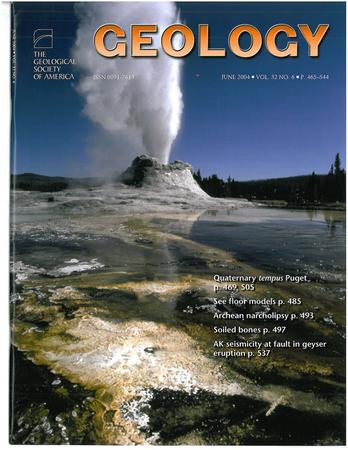追踪中元古代海洋氧化还原变异的空间范围
IF 4.6
1区 地球科学
Q1 GEOLOGY
引用次数: 0
摘要
新出现的地球化学证据表明,中元古代海洋具有相当大的氧化还原非均质性。然而,对不同模式缺氧程度的定量估计仍然缺乏约束。由于铀和钼的氧化还原相关行为具有互补性,因此可以将铀和钼同位素数据结合起来重建古代海洋氧化还原景观,但这种方法尚未应用于中元古代。本文给出了华北克拉通约1.4嘎下马岭组海相岩石的新δ238U和δ98Mo数据,以及独立的氧化还原指标(铁形态和对氧化还原敏感的微量金属)。研究发现,在缺氧或缺氧条件下沉积的样品中,U和Mo含量较低,δ238U和δ98Mo值与大陆地壳难以区分,显示出明显的碎屑信号。相比之下,自生富集U和Mo的富氧样品的自生δ238U和δ98Mo值最高,与U和Mo的有效还原一致。在含铁条件下沉积的样品的中间δ238U和δ98Mo值范围更大,通常落在氧端元和富氧端元之间。使用耦合的U-Mo同位素质量平衡模型,我们推断在大约1.4 Ga的海洋中存在有限的含氧量(占全球海底面积的0.5%),但存在广泛的低生产力(天)含氧和含铁环境。这种氧化还原景观可能为中元古代的真核生物进化提供了潜在的宜居条件。本文章由计算机程序翻译,如有差异,请以英文原文为准。
Tracking the spatial extent of redox variability in the mid-Proterozoic ocean
Emerging geochemical evidence suggests considerable redox heterogeneity in the mid-Proterozoic ocean. However, quantitative estimates of the extent of different modes of anoxia remain poorly constrained. Due to their complementary redox-related behavior, uranium and molybdenum isotope data can be combined to reconstruct ancient marine redox landscapes, but this approach has not been applied to the mid-Proterozoic. We present new δ238U and δ98Mo data for marine rocks from the ca. 1.4 Ga Xiamaling Formation, North China craton, together with independent redox indicators (Fe speciation and redox-sensitive trace metals). We find that most samples deposited under oxic or dysoxic conditions retain low U and Mo contents, with δ238U and δ98Mo values indistinguishable from continental crust, demonstrating a dominant detrital signal. By contrast, euxinic samples with authigenic enrichments in U and Mo record the highest authigenic δ238U and δ98Mo values, consistent with efficient reduction of U and Mo. Samples deposited under ferruginous conditions exhibit a wider range of intermediate δ238U and δ98Mo values that generally fall between the (dys)oxic and euxinic end-members. Using a coupled U-Mo isotope mass balance model, we infer limited euxinia (<0.5% of the global seafloor area) but extensive low-productivity (dys)oxic and ferruginous settings in ca. 1.4 Ga oceans. This redox landscape would have provided potentially habitable conditions for eukaryotic evolution in the mid-Proterozoic.
求助全文
通过发布文献求助,成功后即可免费获取论文全文。
去求助
来源期刊

Geology
地学-地质学
CiteScore
10.00
自引率
3.40%
发文量
228
审稿时长
6.2 months
期刊介绍:
Published since 1973, Geology features rapid publication of about 23 refereed short (four-page) papers each month. Articles cover all earth-science disciplines and include new investigations and provocative topics. Professional geologists and university-level students in the earth sciences use this widely read journal to keep up with scientific research trends. The online forum section facilitates author-reader dialog. Includes color and occasional large-format illustrations on oversized loose inserts.
 求助内容:
求助内容: 应助结果提醒方式:
应助结果提醒方式:


